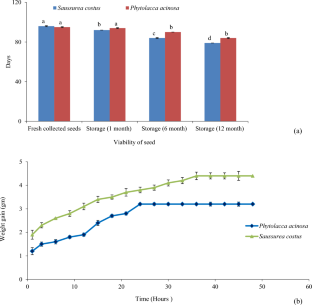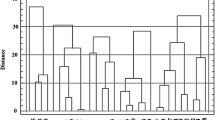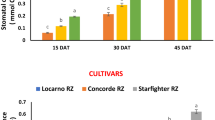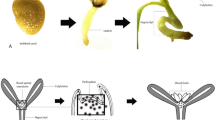Abstract
Medicinal and aromatic plants (MAPs) are gaining popularity globally as a source of raw materials for pharmaceuticals and traditional healthcare systems. More than 85% of herbal medicines used in traditional health care systems are derived from medicinal plants, ensuring millions of people's livelihoods, especially in the Indian Himalayan region (IHR). The wide altitudinal variation, different habitat conditions and varying microclimatic conditions in the Himalayan region form an ideal environment for the growth and development of MAPs. Therefore, the present study focused on standardization of propagation packages (seed germination) of two high-value medicinal herbs (Saussurea costus and Phytolacca acinosa) and analysis of morphological and physiological attributes in different growth conditions. Initially, different combinations and concentrations of PGRs (plant growth regulators) were used for the standardization of seed germination in targeted species. Results revealed the best seed germination for Saussurea costus in GA3 (250 µM) and GA3 (100 µM) for Phytolacca acinosa. These treatments reduced the mean germination time of targeted species, namely S. costus (95% germination with 14 days of MGT) and P. acinosa (80% germination with 11 days of MGT) and improved their germination percentage. After one year, seedlings were transferred to two different growth conditions (open field, and polyhouse) at Sri Narayan Ashram, Pithoragarh district (Altitude 2750 m asl), Uttarakhand for further analyzing the morphological and physiological attributes. Targeted species showed significant (p < 0.05) variation in both growth conditions and exhibited the best performance such as plant height (S. costus—138 cm; P. acinosa—145 cm), number of leaves (S. costus—22 ind; P. acinosa—93 ind), leaf length (S. costus—54.80 cm; P. acinosa—23.60 cm), leaf width (S. costus- 31.80 cm; P. acinosa—12.60 cm) and root length (S. costus—42.40 cm; P. acinosa—24.00 cm) in poly house. Similarly, physiological attributes were recorded significantly higher at poly house conditions like photosynthetic rate (S. costus—15.86 μmol m−2 s−1; P. acinosa—8.66 μmol m−2 s−1), stomatal conductance (S. costus—0.51 mol m−2 s−1; P. acinosa—0.28 mol m−2 s−1), leaf water potential (-0.23 MPa S. costus; -0.25 MPa P. acinosa), and maximal quantum efficiency of photosystem II (ratio Fv/Fm) (S. costus 0.82; P. acinosa 0.82). Furthermore, the analyzed parameters (morphological, physiological, and soil) showed a strong positive relationship. This study's finding revealed that Gibberelic acid concentration (250 µM; 100 µM) are best for seed germination. S. costus and P. acinosa showed higher growth performance and physiological responses at polyhouse conditions, which can be utilized for their large scale cultivation. Furthermore, quality plant materials (seeds, seedlings) can be used for commercial cultivation at barren/ agricultural land of the Indian Himalaya, to reduce pressure on natural resources and fulfill the market demands.





Similar content being viewed by others
Data availability
Data can be made available on request.
References
Ahmad B, Jaleel H, Shabbir A, Sadiq KMMA, Y, (2019) Concomitant application of depolymerized chitosan and GA3 modulates photosynthesis, essential oil and menthol production in peppermint (Mentha piperita L.). Sci Hortic 246:371–379
Anonymous (2011) A review of the status of Saussurea costus (Fale.) Lipsch. in India and the impact of its listing in CITES Appendix I. A study by Traffic India. A Draft Report 19
Bahukhandi A, Joshi K, Kewlani P, Tiwari DC, Jugran AK, Bhatt ID (2023) Comparative assessment of morphological, physiological and phytochemical attributes of cultivated Valeriana jatamansi Jones in Uttarakhand. West Himalaya Plant Physiol Biochem 200:107751
Basnet S, Gaire NP, Chhetri PK (2019) Fire history and climate-growth response of Abies spectabilis: a case from Langtang National Park, Nepal Himalaya. Banko Janakari 29:3–12
Chaturvedi AK, Vashistha RK, Rawat N, Prasad P, Nautiyal MC (2009) Effect of CO2 enrichment on photosynthetic behavior of Podophyllum HexandrumRoyle, an endangered medicinal herb. J Am Sci 5(5):113–118
Chone X, Van Leeuwen C, Dubourdieu D, Gaudillere JP (2001) Stem water potential is a sensitive indicator of grapevine water status. Ann Bot 87:477–483
Deenadayal DS, Vidyasagar D, Naveen Kumar M, Sudhakshin P, Sharath Chandra SV, Hameed S (2013) Spontaneous CSF rhinorrhea our experience. Indian J Otolaryngol Head Neck Surg 65:271–275
Gaira KS, Dhar U, Belwal OK (2011) Potential of herbarium records to sequence phenological pattern: a case study of Aconitum heterophyllum in the Himalaya. Biodivers Conserv 20:2201–2210
Gaira KS, Rawal RS, Rawat B, Bhatt ID (2014). Impact of climate change on the flowering of Rhododendron arboreumin central Himalaya, India. Curr Sci 1735–1738
Guidi L, Lo Piccolo E, Landi M (2019) Chlorophyll fluorescence, photoinhibition and abiotic Stress: does it make any difference the fact to Be a C3 or C4 Species. Front Plant Sci 10:1–11
Gupta R, Chakrabarty SK (2013) Gibberellic acid in plant: still a mystery unresolved. Plant Signal Behav 8:25504
Joshi SC, Chandra S, Palni LMS (2007) Differences in photosynthetic characteristics and accumulation of osmo protectants in saplings of evergreen plants grown inside and outside a glasshouse during the winter season. Photosynthetica 45:594–601
Jugran AK, Bahukhandi A, Dhyani P, Bhatt ID, Rawal RS, Nandi SK, Palni LMS (2015) The effect of inoculation with mycorrhiza: AM on growth, phenolics, tannins, phenolic composition and antioxidant activity in Valeriana jatamansi Jones. J Soil Sci Plant Nutr 15:1036–1049
Kuniyal CP, Heinen JT, Negi BS, Kaim JC (2019) Is cultivation of Saussurea costus (Asterales: Asteraceae) sustaining its conservation? J Threat Taxa 11:14745–14752
Li PM, Cheng L, Peng T, Gao HY (2009) CO2 assimilation and chlorophyll fluorescence in green versus red Berberis thunbergii leaves measured with different quality irradiation. Photosynthetica 47:11–18
Liu T, Chen Z, Li Z, Fu H, Chen G, Feng T, Chen Z (2021) Preparation of magnetic hydrochar derived from iron-rich Phytolacca acinosa Roxb. for Cd removal. Sci Total Environ 769:145159
Ma L, Sun X, Kong X, Galvan JV, Li X, Yang S, Hu X (2015) Physiological, biochemical and proteomics analysis reveals the adaptation strategies of the alpine plant Potentilla saundersiana at altitude gradient of the Northwestern Tibetan Plateau. J Proteom 112:63–82
Manzoor N, Wani I, Singh KP, Pal A (2017) Evaluation of antioxidant property of hydro-alcohol root extract from Inula racemosa and Phytolacca acinosa in Kashmir valley. Glob J Med Plant Res 6:114–120
Mathur S, Jain L, Jajoo A (2018) Photosynthetic efficiency in sun and shade plants. Photosynthetica 56:354–365
Maxwell K, Johnson GN (2000) Chlorophyll fluorescence-a practical guide. J Exp Bot 51:659–668
Pandey S, Kumar S, Nagar PK (2003) Photosynthetic performance of Ginkgo biloba L. grown under high and low irradiance. Photosynthetica 41:505–511
Pandey V, Tiwari DC, Dhyani V, Bhatt ID, Rawal RS, Nandi SK (2021) Physiological and metabolic changes in two Himalayan medicinal herbs under drought, heat and combined stresses. Physiol Mol Biol Plant 27:1523–1538
Panthi S, Fan ZX, van der Sleen P, Zuidema PA (2020) Long-term physiological and growth responses of Himalayan fir to environmental change are mediated by mean climate. Glob Change Biol 26:1778–1794
Panwar P, Pal S, Loria N, Verma MR, Alam NM, Bhatt VK, Mishra PK (2019) Variability and time series trends of rainfall and temperature in Indian Himalaya. J of Agrometeorol 21:220–223
Rathore S, Debnath P, Kumar R (2021) Kuth Saussurea costus (Falc. Lipsch.: a critically endangered medicinal plant from Himalaya. J Appl Res Med Aromat Plants 20:100277
Rezvani M, Bengar JA, Nikkhah Kouchaksaraei H (2021) Seed dormancy breaking and germination of pokeweed and lamb’s ear: two invasive plants. Annali Di Botanica 2:67–76
Samant SS, Dhar U, Palni LMS (1998) Medicinal Plants of Indian Himalaya. Gyanodaya Prakashan
Sharma S, Arunachalam K, Phondani P (2019) Variation in yield and composition of Perilla frutescens essential oil across altitudinal gradients in the Indian Himalayan Region. Iran J SciTechnol Trans A Sci 43:369–378
Tewari A, Shah S, Singh N, Mittal A (2018) Treeline species in Western Himalaya are not water stressed: a comparison with low elevation species. Trop Ecol 59:222–234
Acknowledgements
The authors are thankful to Professor Sunil Nautiyal, Director, Govind Ballabh Pant National Institute of Himalayan Environment (GBP-NIHE) for the facilities and encouragement.
Funding
Financial support received from In House Project-04 (GBP-NIHE) entitled "Mainstreaming Himalayan Biodiversity for Sustainable Development", and the National Mission on Himalayan Studies (NMHS) funded project entitled "Promoting conservation of threatened plant species in the West Himalayan region—A participatory approach" in Chaudas Valley (project number NMHS_IDB_MG_34) is gratefully acknowledged.
Author information
Authors and Affiliations
Contributions
Deep C. Tiwari: Data curation, analysis, manuscript editing, Amit Bahukhandi: Data curation, formal analysis, experimental design, literature review manuscript writing. VD: Data curation, experimental design, NP: Data curation, IDB: Conceptualization, supervision, main editing manuscript. All the authors were then involved in the final review and editing. All authors have read and agreed to the published version of the Manuscript.
Corresponding author
Ethics declarations
Conflict of interest
All the Authors declare no conflict of interest in the present Manuscript.
Additional information
Publisher's Note
Springer Nature remains neutral with regard to jurisdictional claims in published maps and institutional affiliations.
Rights and permissions
Springer Nature or its licensor (e.g. a society or other partner) holds exclusive rights to this article under a publishing agreement with the author(s) or other rightsholder(s); author self-archiving of the accepted manuscript version of this article is solely governed by the terms of such publishing agreement and applicable law.
About this article
Cite this article
Tiwari, D.C., Bahukhandi, A., Dhyani, V. et al. Comparative assessment of morphological, physiological attributes of two high value medicinal herbs of Himalaya under different growth conditions. Vegetos (2024). https://doi.org/10.1007/s42535-024-00839-x
Received:
Revised:
Accepted:
Published:
DOI: https://doi.org/10.1007/s42535-024-00839-x




